Guide What Is a DSG Gearbox? Everything You Need to Know
In this guide, we’ll break down exactly what a DSG gearbox is, how it works, why it’s special, and whether it might be a good fit for you. If you’ve come across the term “DSG gearbox” while car shopping or researching vehicle tech, you might be wondering what it actually means. DSG stands for Direct Shift Gearbox, and it’s a type of transmission that blends the best of both manual and automatic systems.
So, What Exactly Is a DSG Gearbox?
A DSG gearbox is essentially a dual-clutch transmission (DCT) designed to give you the smoothness of an automatic with the performance and control of a manual. Volkswagen is one of the main brands that developed this tech, but other carmakers use it too. The key feature? It uses two clutches—one for odd-numbered gears (1st, 3rd, 5th) and one for even-numbered gears (2nd, 4th, 6th)—to deliver faster, more seamless gear shifts.
The result is quicker acceleration, smoother driving, and often better fuel efficiency compared to traditional automatic or manual transmissions.
How Does a DSG Gearbox Work?
The magic of the DSG gearbox is in its dual-clutch system. Here’s how it works:
- One clutch controls the odd gears (1st, 3rd, 5th).
- The other clutch manages the even gears (2nd, 4th, 6th).
When you’re driving, the gearbox pre-selects the next gear using the clutch that’s not currently engaged. For instance, when you’re in 2nd gear, the system has 3rd gear already lined up. This allows for incredibly fast and smooth shifts—often much quicker than traditional automatics or even manual shifting.
Why Choose a DSG Gearbox?
There are several reasons why drivers love DSG gearboxes. Here’s a look at the benefits:
1. Super Fast Gear Changes
One of the biggest perks of a DSG is how quickly it changes gears. Because the next gear is already prepared, shifts happen almost instantly, giving you smoother acceleration and better performance.
2. Better Fuel Efficiency
DSG gearboxes are usually more fuel-efficient than traditional automatics. The quick and smooth shifts reduce energy loss, which helps your engine run more efficiently. So if you’re looking to save on fuel, this could be a great option.
3. Smooth Driving Experience
If you’ve ever felt the slight jolt or lag when shifting gears in a regular car, you’ll appreciate the smoothness of a DSG. The transitions between gears are almost unnoticeable, making for a more comfortable ride, especially in stop-and-go traffic.
4. Manual Mode for More Control
A lot of cars with DSG gearboxes also come with paddle shifters or a manual mode. This allows you to take control when you want a more hands-on driving experience, without having to deal with a clutch pedal.
5. Longer Lifespan for Clutch Components
Since the DSG alternates between two clutches, each clutch gets less wear and tear than it would in a single-clutch system. This means parts could last longer, potentially saving you money on maintenance.
Are There Any Downsides?
While DSG gearboxes have a lot of perks, they’re not perfect. Here are a few issues that some drivers encounter:
1. Low-Speed Lag
Some drivers notice a slight hesitation or lag when driving at low speeds or pulling away from a stop. It’s not a deal-breaker for most people, but it can feel a bit awkward, especially in city driving.
2. Higher Repair Costs
DSG gearboxes are more complex than traditional automatic or manual transmissions, which means that repairs can be pricier. If something goes wrong with the dual-clutch system, you might need a specialist to fix it.
3. Clutch Wear
Even though DSG systems are generally durable, the clutches can wear out, especially if you do a lot of stop-and-go driving. Regular maintenance is key to keeping everything in good shape.
DSG vs. Automatic and Manual: How Do They Compare?
Wondering how a DSG stacks up against the more common automatic and manual transmissions? Let’s break it down:
DSG vs. Automatic
- Quicker Shifts: DSGs shift faster and more smoothly than traditional automatics.
- Better Fuel Economy: DSG transmissions tend to be more fuel-efficient.
- Cost: DSG-equipped cars are often a bit pricier than cars with regular automatics.
DSG vs. Manual
- Convenience: DSGs give you the control of a manual without needing to deal with a clutch pedal.
- Performance: Even a seasoned driver can’t shift as quickly as a DSG system can.
- Maintenance: DSG systems are more complex, and repairs can be more expensive compared to manual transmissions.
How to Take Care of Your DSG Gearbox
Keeping your DSG gearbox in good condition comes down to regular maintenance. Here’s how to keep it running smoothly:
- Transmission Fluid Changes: DSG gearboxes need specific transmission fluid to function correctly. Stick to the manufacturer’s recommendations for when to change it.
- Clutch Inspections: Even though DSG clutches last a long time, it’s a good idea to have them checked regularly to avoid any surprises.
- Software Updates: Many DSG gearboxes are controlled by software, so make sure to keep your car’s system updated. It can fix issues and improve performance.
A DSG gearbox offers an impressive balance of performance, fuel efficiency, and smooth driving. It’s ideal for drivers who want the ease of an automatic transmission with the sporty feel of a manual. However, keep in mind that maintenance costs can be higher, and you might experience a slight lag at low speeds. If you want quick gear shifts, better fuel economy, and the option for manual control, a car with a DSG gearbox could be the perfect fit for you.
Buying a used VW. Buying used vauxhall, BMW, Jaguar, Ford, Volvo, Range rover, Bentley, Aston Martin, Porsche, Ferrari, Lamborghini, Maserati, Hyundai, Tesla, Honda, Pagani

